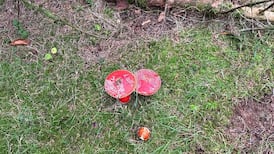The eyrie of my Dublin bachelorhood, back in the 1960s, was a dinky pad carved out of a roof space high at the heart of Ballsbridge. It looked up to the wheeling swifts of summer skies and down to the starlings roosting in trees across the road, marking their overnights on cars outside the city’s glossiest hotel.
Occasionally, a herring gull, or even two, would perch upon my parapet, bringing pleasure in their sleek and pristine plumage, with its hints of wind and wave. The red spot on the bill might prompt a passing thought of Niko Tinbergen, of Oxford University, famous for showing that the spot triggers an instinct for gull chicks to peck at it to beg for food. (A red spot on a pencil works just as well.) He was properly famous for much more, of course, but that's the bit that gets remembered.
He also thought that “the voice of the herring gull is wonderfully melodious”, which is not at all how it seemed to the people, especially in Dublin, who were complaining through the summer at the “squawking” that was waking them too early. Indeed, the tirade of resentment unleashed against the gulls was a match for anything offered by gull-busy cities across these islands, from Bristol to Aberdeen. The Fianna Fáil senator who charged that the birds had “lost the run of themselves”, threatening little dogs and harassing children for their sweets, found himself widely popular.
In August, a 22-year-old Aberdeen medical student offered a contemporary experience. There he was, walking along eating “a small bit of focaccia”, when one of the gulls that had been following him swooped and hit him in the face. “It bust my lip open and grabbed the piece of food out of my mouth as I was eating it – it stuck its beak in my mouth.” Hitchcock could not have done better.
Why the gulls – herring and black- backed – have moved into the cities scarcely needs rehearsing: the cascading manna of waste human food, flat roofs as safe islands for nesting, processions of people clutching takeaways. (In Brighton, where I grew up, the gulls now demand to share your fish and chips as you walk along the pier.)
It is the apparently new abundance of rooftop gulls and the rapid build-up of noisy colonies on suburban housing estates that has upset so many people. The Irish population has, however, suffered dramatic swings of fortune. In the 1980s, the bulk of the 20,000-strong breeding colonies on Lambay Island, off Co Dublin, were wiped out on official orders as a possible hazard to planes using Dublin Airport. Earlier, the long hot summer of 1976 brought the first, dramatic episode of botulism, a bacterial toxin contracted by the birds as they slashed open bags of fermenting food waste at city rubbish dumps.
By 2000, a national seabird survey could find only some 6,000 breeding pairs in Ireland – a drop of 90 per cent in 30 years. BirdWatch Ireland puts the current number in the Republic at a mere 5,500 pairs and continues to red-list the bird as “of critical conservation importance”. As part of an action plan for urban and suburban birds, it will research the impact of botulism on the gulls’ breeding success.
While the mores of our east-coast herring gulls may sometimes echo the worst stories from across the Irish Sea, their urban numbers have not followed, so far, the exponential surge in Britain. In Bristol a single pair of the birds in 1972 had increased to some 1,200 pairs by 2004. Peter Rock, an associate researcher at Bristol University, predicted a possible UK population of more than a million pairs of urban- nesting gulls by this year, 200,000 of them in cities around the Severn Estuary.
Many British local authorities now offer control measures, removing nests and eggs free of charge and promoting the “proofing” of roofs with spikes around chimneys, nets and parallel wires. There have been fashions for plastic eagle owls and taped distress calls. Spraying the roof with the garden hose, spraying the eggs with oil – nothing, says Rock, is likely to work in the long term, so long as cities offer such advantages to a clever, scavenging species.
Herring gulls will fly 100km for food. A resident of Palmerstown, in west Dublin, a mere 10km from the sea, left the skins of salmon steaks out on the lawn, for her garden birds, only to have herring gulls arrive within a minute. "It happens every time," she told Eye on Nature. "How do they know?"
Salmon, focaccia, kebabs, fish and chips: the gulls’ takaway tastes are developing fast. Once, on a winter visit to Dublin, I paused to watch one stamping in a repeated staccato on the lawn beside the Natural History Museum. It was an attempt to lure earthworms to poke their heads out, hearing raindrops. How much longer will the birds bother with such laborious evolutionary devices?










